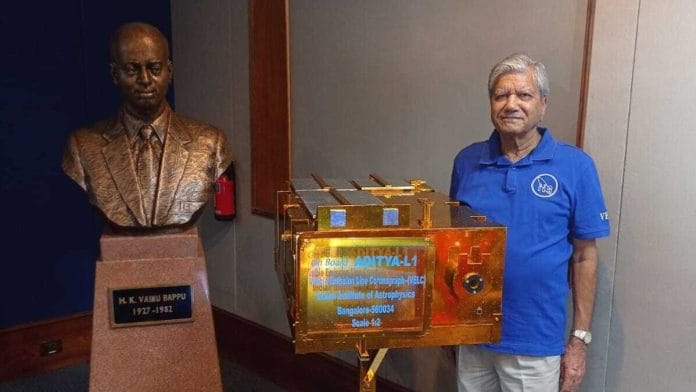New Delhi: On the morning of 2 September, 2023—just a fortnight after India’s successful landing near the lunar south pole—the Indian Space Research Organisation (ISRO) launched its first mission to study the Sun, Aditya-L1.
As the nation collectively cheered and praised the Indian space agency for the launch, Jagdev Singh from Bengaluru’s Indian Institute of Astrophysics (IIA) silently watched his work of 17 years finally come to fruition.
Singh, the first principal investigator of the Aditya-L1 mission, said that he was met with scorn and surprise when he first pitched the idea of observing the Sun from space instead of conducting only ground-based scrutiny. It took years to convince the management of his institute, the government and even ISRO scientists that this could be successfully executed. Finally, a year since its launch, observations from Aditya-L1 are being taken note of by scientists worldwide.
“I do not want any credit. When I saw the mission take flight, I felt all those efforts were worth it,” said Singh. Today, his “idea” promises to predict coronal mass ejections and study space weather like never before.
Speaking to ThePrint on the first anniversary of Aditya-L1’s launch, the scientist added that he had first proposed the mission in 2006. “Initially, we also faced problems with funding. But in 2023, when Aditya-L1 took off, it was a great achievement,” he said.
Excerpts from the interview:
How was Aditya-L1 conceived? What were the initial challenges?
I had a lot of experience observing total solar eclipses. However, during a total solar eclipse, we get only a few moments to observe. I had done this for 10 years already, but could only manage data for 40-50 days. That’s when I realised that we needed to go to space. Ground-based observations were insufficient to carry out the scientific observations needed.
With my experience, we could do something different from what the Americans and Europeans had already done. We thought of designing our experiments to work in the visible range—the green and the red lines. This had not been done before. That’s how the idea of the Visible Emission Line Coronagraph (VELC) was developed.
It took a year or so to convince the management. When the proposal was accepted, it got stuck at ISRO. They told us they did not have the required technology to carry it out. But by 2010, four years after the initial proposal was made, ISRO agreed to develop the technology.
It took time to convince the agency of the importance of studying the Sun from space because back then, this was “still a dream”. Around 100 years ago, if you would ask someone if it was possible to land a human on the Moon, they would laugh it off. Just like that, such a mission was also a dream.
Also read: ISRO prepares for responsible space missions, aims to go debris-free by 203
What is the significance of the mission?
There are seven payloads on Aditya-L1. I am happy to tell you that all are working very well. Aditya-L1 is a mini laboratory. It looks at the sun and its atmosphere from all angles and also takes some in-situ measurements. Till now, all solar missions in the world could go only to a certain point. They could not get close to the sun.
Now, why is our mission important? When solar flares happen, it causes coronal mass ejections (CMEs). A lot of high-energy particles are ejected out of the sun in a few minutes. When they travel to Earth, they damage the atmosphere, electrical grades, etc. So, it becomes important to predict when these CMEs will reach the Earth’s ionosphere. The initial CMEs are very important in predicting the actual time of arrival.
Secondly, we still don’t know how coronal plasma gets heated. Since our observations are throughout the day, we will now be able to find answers to how this happens. When we find these answers, we will be able to solve many electricity-related problems on Earth.
When we gain knowledge, science develops, technology develops, the industry develops, and overall the nation develops.
What kind of data are you getting from Aditya-L1?
For the first three-four months after Aditya-L1 reached Lagrange Point-1, ISRO was checking and confirming the health of the payloads. Then, we spent some time solving minor issues. There were issues with the VELC’s optical access.
We are now taking pictures of the outer atmosphere of the corona, whereas SUIT (Solar Ultraviolet Imaging Telescope) is taking DISC images. We are getting different kinds of data. We have data for about three-four months which we are analysing. We will soon have an analysis on the dynamics of CMEs and will be able to tell you how it develops.
(Edited by Tikli Basu)
Also read: ‘We are scientists, not beggars’. Indian Science Congress is in a war against govt






